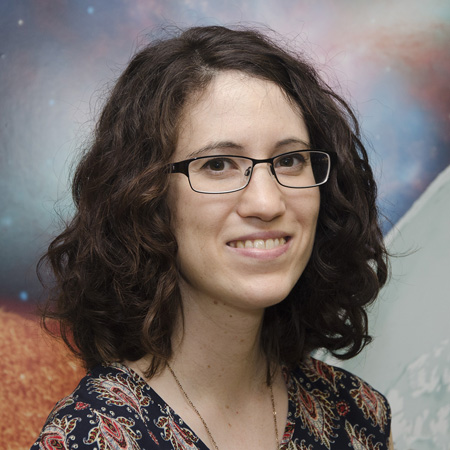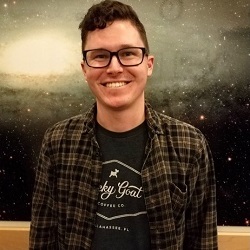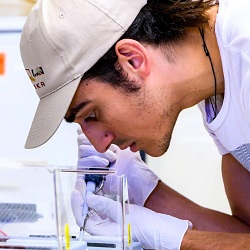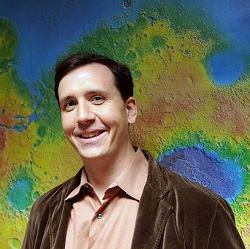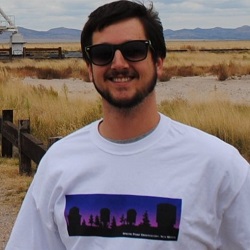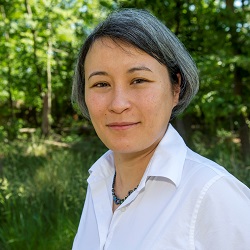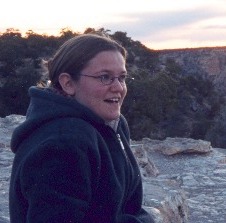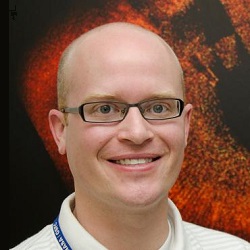In this Task, VPL Team members make observations of Solar System and extrasolar planets, develop astronomical and remote-sensing retrieval methods, and use telescope and instrument simulators to determine required measurements, observing strategies, and analysis techniques for exoplanet characterization. New simulation capabilities are validated against the Earth datasets provided in Task A. To assess the detectability of signs of habitability and life, input spectra for the simulators and detectability calculations are generated from the environments developed in Tasks A, B, C and D.
Atmospheric spectra of a handful of transiting Jovian, mini-Neptune planets currently exist, but spectroscopy of transiting super-Earths will likely await the launch of NASA’s JWST. Direct imaging of Earth-sized planets in the habitable zone awaits the development of TPF-class missions. In all these cases, the data returned will be far more challenging to interpret than conventional terrestrial or planetary remote-sensing observations. The spectral resolution, spectral range and S/N are likely to be minimal, and the disk of the planet will be unresolved (disk-integrated), so planetary spectra will include mixtures of surface types and cloudy and clear scenes, and the planetary environment may be unlike anything currently known.
To prepare for the interpretation of this challenging data, VPL team members explore and quantify the types of signals we might expect to see from different metabolisms and planetary environments.
For more information about VPL’s relevance to NASA missions, click here.
Observations
Examples of our recent work include a variety of tools and techniques to discover and characterize exoplanets. In recent exoplanet discovery and observations, Agol was part of the ‘Citizen Scientists’ team that discovered a new super-Neptune planet and characterized its multi-planet system (Schmitt et al., 2014). This demonstrated techniques to determine precision masses of exoplanets, which can be applied to habitable zone exoplanets in the future. Agol was also involved in detecting and characterizing new planets in the Kepler data, including the first 7-transiting planet system, Kepler-90 (Lissauer et al., 2014) Raymond was part of the team that discovered Kepler 186f, the first Earth-sized planet found in the habitable zone of an M dwarf star (Quintana et al., 2014). VPL members Sheets and Deming (2015) measured and coadded reflected light from Kepler planets smaller than Saturn, finding that they have low (~20%) geometric albedos. This new technique probes the nature of small planet atmospheres and may eventually lead to an understanding of the atmospheres of super-Earths. In exoplanet spectroscopy, Deming participated in HST transit observations of HAT-P 11b, a Neptune-sized planet that showed clear skies with water vapor absorption clearly detected in the spectrum (Fraine et al., 2014). We hope to extend this measurement technique to transiting habitable super-Earth (to be discovered by TESS).
Tools And Techniques
In addition to observations, we have recently developed several new detection techniques for planets and their moons. New, fast techniques to calculate the size of the perturbation expected to planetary orbits as planets pass by each other were developed that can potentially be used to measure the masses of Earth-sized exoplanets with JWST (Deck & Agol, 2015). Agol, Robinson and Meadows developed new techniques to detect and characterize exomoons and their parent planets, using spectroastrometry, the measurement of the center of light in a planet/moon system at different wavelengths (Agol et al., 2015). This technique may allow for detection of potentially habitable exomoons, as well as mass measurements and disentangling of the spectra for the exoplanet/exomoon system. Misra, Krissansen-Totton and colleagues collaborated on a paper to understand whether a volcanically active planet could be identified using transmission spectra by searching for the sporadic formation of high altitude hazes due to volcanic outgassing (Misra et al., 2015). Robinson co-wrote a study of techniques for 1-D thermal structure modeling for planetary and brown dwarf atmospheres (Robinson & Marley, 2015). And in further developments in instrument models and retrieval for potentially habitable exoplanets, Robinson and colleagues developed an instrument noise mode suitable for studying the spectral characterization potential of a coronagraph-equipped, space-based telescope and applied it to a broad set of rocky and gaseous exoplanet types (Robinson, Stapelfeldt & Marley, 2015). This is being used to explore the capability of near-future coronagraphic missions (like WFIRST-AFTA) to detect biosignatures gases in the atmospheres of nearby Earths and super-Earths.

Discriminating Between Biosignature Imposters And Real Signs Of Life
VPL research is now developing better ways to identify abiotically produced O2/O3 by determining which gases or other environmental characteristics are more likely to be present for abiotic generation. As the direct detection of nitrogen would provide a means to characterize the bulk atmosphere of potentially habitable exoplanets and constrain the likelihood of oxygen production by abiotic processes, Schwieterman, Robinson, Meadows, Misra, and Domagal-Goldman explored a novel way to detect and quantify N2 in planetary atmospheres (Schwieterman et al., 2015). Although the N2 molecule is extremely challenging to observe in exoplanet spectra, N2 has a collisional-induced absorption band near 4.2 µm, which is significant in Earth’s spectrum and potentially in those of Earth-like exoplanets with similarly N2-dominated atmospheres. The VPL team quantified the potential magnitude of this spectral signature by producing synthetic transit transmission and radiance spectra using VPL radiative transfer models. In another study, VPL Researchers Harman, Schwieterman, and Kasting (Harman et al., 2015) examined what would happen if the early Earth was orbiting around different stars, ranging from a star slightly more massive than the Sun (an F type star) to a star less than half the mass of the Sun (an M type star). For the Earths orbiting smaller stars, the interaction between the atmosphere of the planet and the radiation from the star meant that some abiotic oxygen was produced. This could mean that when we look at distant planets around some types of stars, the presence of oxygen alone may not be a sure sign of life. To pick out false positives such as this, Schwieterman, Meadows, Domagal-Goldman, Deming, Arney, Luger, Harman, Misra and Barnes (Schwieterman et al., 2016) published a seminal paper on using CO in transmission and O4 in both transmission and direct imaging spectra to help discriminate between abiotic O2/O3 produced by atmospheric loss or photochemistry, and O2 produced by a photosynthetic biosphere.

GJ 1214b
Mini-Neptune GJ 1214b is an exciting target for study because it is near enough to spectrally characterize. However, to date, its spectrum has revealed little except that the planet has a high altitude cloud or haze layer obscuring the lower atmosphere. To model mini-Neptunes and ultimately learn how these – likely uninhabitable – worlds can be discriminated from habitable super-Earths, NPP posdoc Benjamin Charnay, along with Meadows, Misra and Arney developed 3D models of GJ1214b’s atmosphere using the Laboratoire Meteorologie Dynamique’s LMDZ. Charnay, Meadows & Leconte, (2015a), described the new LMDZ mini-Neptune model and analyzed the atmospheric circulation and the transport of tracers in GJ1214b’s atmosphere, which are important to understand the photochemistry and cloud formation on mini-Neptunes. In Charnay et al., (2015b) we performed the first 3D simulations of realistic clouds on a gaseous exoplanet, and validated the model by reproducing the observed HST transit spectrum of GJ1214b. We then predicted what information could be obtained with future telescopes and in particular showed that mini-Neptunes should show strong features from molecules longward of 3um in JWST transit spectra, even if haze precludes deeper observations at visible wavelengths. This work provides insight into the best observational techniques to decipher cloudy atmospheres, and how to distinguish mini-Neptunes from potentially habitable ocean exoplanets.
Detectability Of Life On An Anoxic World
For a third of life’s history on Earth, the planet’s atmosphere contained little or no oxygen. In such an “anoxic” environment, two of the main biosignature gases (O2 and O3) would not build up to detectable concentrations. In Domagal-Goldman et al. (2011) VPL researchers show how biogenic sulfur gases could be used as biosignatures for such a planet. We found that for extremely high production rates of these gases, or for planets around stars with low UV-fluxes, these gases would be directly detectable. We furthermore found that for lower (modern-day) fluxes on planets around cooler stars than our Sun, the effects of these gases on atmospheric chemistry could be detected via an increase in the planet’s ethane to methane ratio. This work lays out a strategy for finding life on an anoxic planet, a type of biosphere that could represent a significant portion of the inhabited planets in the universe.

Click to See Researchers Working on This Task
Email: giada.n.arney@nasa.gov Website: CV / Publications: https://science.gsfc.nasa.gov/sed/bio/giada.n.arney VPL Focus: Task A, Task B (Lead), Task E
Bio: My research has involved modeling and measuring properties of planets with an emphasis on worlds enshrouded by global cloud and haze layers because aerosols appear to be a common planetary phenomeon. I have a dual focus on both solar system bodies and on exoplanets. I have retrieved properties of Venus’ sub-cloud atmosphere through observations of its nightside spectral windows, producing the first simultaneous and temporally resolved maps of cloud opacity, acid concentration, water vapor (H2O), hydrogen chloride (HCl), carbon dioxide (CO), carbonyl sulfide (OCS), and sulfur dioxide (SO2). I also have extensive modeling experience of planetary atmospheres and have comprehensively simulated hazy Archean Earth with a coupled photochemical-climate model to study its atmospheric composition, climate, and habitability. Using a sophisticated radiative transfer model together with a coronagraph noise model and a JWST model, I showed that organic haze on an Earthlike planet produces strong spectral signatures that may be detectable with future telescopes. In addition, I helped lead a paper on Proxima Centauri b’s possible climatic and environmental states and their spectral discriminants, and I have been involved in work identifying oxygen false positive biosignature signals. My current and near-future research focuses on modeling the atmospheric and climatic states of exoplanets, understanding the observational requirements to discriminate between different planetary states with current and future observatories, and re-visiting Venus with new observations.
Email: j.bailey@unsw.edu.au
VPL Focus: Task A, Task E
Bio:
Email: kbott@ucr.edu
VPL Focus: Task E
Bio:
My research combines observation, instrumentation, and theoretical approaches to characterizing exoplanets and finding realistic means to determine their habitability. My recent work has specialized in polarimetry of potentially habitable terrestrial exoplanets. I have helped develop radiative transfer code for both transits and polarimetry; am experienced in instrument design, fabrication, and testing (polarimeters and other instruments); and have observed a variety of objects (galaxies, red dwarf stars, planet hosting systems, etc.) using a variety of instruments (e.g. aperture polarimeters, IFUs, vis & IR photometers, etc.). My work has disputed the first detection of polarized light from an exoplanet, eliminated certain cloud scenarios for a hot Jupiter, provided guidelines for reliable polarized light detection from exoplanets, improved the modelling software available for radiative transfer (including polarization), and provided estimates of polarimetric signals from realistic terrestrial and super Earth scenarios utilizing climate models, with comparisons of polarimetry to other characterization methods. I am deeply aware of the needs of software development and laboratory inputs to enable the use of models in the detection and characterization of exoplanets and the icy moons of our Solar System, as well as of the observational needs for such endeavors.
Email: benjamin.charnay@lmd.jussieu.fr
VPL Focus: Task B, Task C, Task E
Bio:
My research topic is the physics and dynamics of planetary atmospheres. I have been focussing on the dynamics of Titan’s troposphere and the climates of the early Earth. Now, I am also studying the atmospheres and climates of exoplanets (i.e. dynamics, photochemistry, clouds and haze). I study these atmospheres with 3D Global Climate Models (GCMs).
Research interests:
- Titan’s troposphere (dynamics, planetary boundary layer, surface winds and dune formation)
- Climatic evolution of Titan
- Climates of the early Earth (faint young Sun problem and formation of organic haze)
- Habitability of exoplanets
- Exoplanetary atmospheres (super-Earths and Neptune-size planets)
Email: mcurr@uw.edu
VPL Focus: Task A, Task E
Bio:
Email: cdavis45@uw.edu
VPL Focus: Task C, Task E
Bio:
Email: shawn.goldman@nasa.gov
VPL Focus: Task B (Lead), Task D, Task E
Bio:
Shawn Domagal-Goldman in a Research Space Scientist in the Planetary Environments Laboratory at NASA’s Goddard Space Flight Center in Greenbelt, MD. He is an astrobiologist that focuses on comparative planetology. As a member of multiple interdisciplinary teams, he simulates the atmospheres of other worlds, including those of ancient Earth, modern Mars, ancient Mars, and exoplanets. He utilizes the outputs from those simulations to interpret data from some of Earth’s most ancient rocks, from the Mars Curiosity rover, and to simulate the capabilities of future space-based telescopes designed to look for life on exoplanets. Shawn is a collaborator by nature, and a member of many research and mission teams, including the Curiosity science team, the HabEx Science and Technology Definition Team, the Large UV-Optical-Infrared Surveyor (LUVOIR) Study Office, is on multiple research teams in the Nexus for Exoplanet Systems Science (NExSS).
Email: agol@uw.edu
VPL Focus: Task E (Lead)
Bio:
Eric Agol studies transits of extrasolar planets, for which he has created a widely used modeling code and helped originate the idea of detecting and characterizing planets using transit time variations.
He is a former member of the Kepler team, with which he led the discovery and characterization a closely orbiting super-Earth and mini-Neptune (Kepler 36), and he helped to characterize two circumbinary planet systems, including the first two-planet system orbiting a binary star (Kepler 38 and 47).
He first postulated the possibility of long-lived habitable planets around white dwarf stars (if they could form or migrate inward, and retain volatiles). He is also interested in atmospheric modeling of hot jupiters, coronagraphic imaging, radial velocity surveys, and mapping of extrasolar planets (using their time-dependent variation). He has recently helped to characterize the Earth-sized transiting exoplanets in the TRAPPIST-1 system
Email: david.crisp@jpl.nasa.gov
VPL Focus: Task E (Lead)
Bio:
Dr. David Crisp is an atmospheric physicist and a Senior Research Scientist at the Jet Propulsion Laboratory, California Institute of Technology.
Since receiving his Ph.D. from the Geophysical Fluid Dynamics Program at Princeton University in 1984, he has focused primarily on the development of radiative transfer algorithms for remote sensing and climate models of Venus, Earth, and Mars. Dr. Crisp has served on the science teams of several missions including the Venus VEGA Balloon Mission, Hubble Space Telescope Wide Field/Planetary Camera 2 (WFPC2), Mars Pathfinder Lander Atmospheric Structure Instrument, Mars Polar Lander MVACS Meteorology Experiment, and ESA Venus Express. He contributed to the NASA technology program by developing in situ atmospheric structure and meteorological instruments and serving as the Chief Scientist of the NASA New Millennium Program, from 1998 to 2001.
Dr. Crisp was the Principal Investigator of the Earth System Science Pathfinder (ESSP) Orbiting Carbon Observatory (OCO) mission, NASA’s first dedicated carbon dioxide measurement mission. He is currently serving as the Science Lead of the OCO-2 Mission.
Email: thomas.j.fauchez@nasa.gov
VPL Focus: Task E
Bio:
Email: nancy.y.kiang@nasa.gov
VPL Focus: Task D (Lead), Task E
Bio:
Dr. Kiang conducts research on the interaction between the biosphere and the atmosphere, focusing on life on land. Through photosynthesis and the evapotranspiration of water from plant leaves, seasonal cycles of growth and decay, and occasional big events like fires, the biosphere on Earth exchanges heat, water vapor, carbon dioxide, methane, nitrogen in different forms, and many other compounds with the atmosphere. These exchanges result in the biosphere actively controlling the climate and spectral properties of the Earth.
Dr. Kiang also relates this work to research in astrobiology, particularly with regard to how photosynthetic activity produces signs of life at the global scale (e.g., biogenic gases like oxygen and photosynthetic pigments like chlorophyll) and how these may exhibit adaptations to alternative environments on extrasolar planets, resulting in other “biosignatures” that might be detected by space telescopes.
Her work includes computer simulation modeling of vegetation dynamics coupled to atmospheric general circiulation models (GCMs), occasional fieldwork, and theoretical studies on the thermodynamic efficiency of photon energy use in photosynthesis. Dr. Kiang splits her time between New York and Los Angeles.
Selected Publications:
Mielke, S.P., N.Y. Kiang, R.E. Blankenship, M.R. Gunner, and D. Mauzerall, 2011: Efficiency of photosynthesis in a Chl d-utilizing cyanobacterium is comparable to or higher than that in Chl a-utilizing oxygenic species. Biochim. Biophys. Acta Bioenerg., 1807, 1231-1236, doi:10.1016/j.bbabio.2011.06.007.
Kiang, N.Y., 2008: The color of plants on other worlds. Sci. Amer., 298, no. 4, 48-55. (Cover article)
Kiang, N.Y., A. Segura, G. Tinetti, Govindjee, R.E. Blankenship, M. Cohen, J. Siefert, D. Crisp, and V.S. Meadows, 2007: Spectral signatures of photosynthesis II: Coevolution with other stars and the atmosphere on extrasolar worlds. Astrobiology, 7, 252-274, doi:10.1089/ast.2006.0108.
Kiang, N.Y., J. Siefert, Govindjee, R.E. Blankenship, and V.S. Meadows, 2007: Spectral signatures of photosynthesis I: Review of Earth organisms. Astrobiology, 7, 222-251, doi:10.1089/ast.2006.0105.
Email: alinc@uw.edu
VPL Focus: Task C, Task E
Bio:
Andrew is a graduate student pursuing a dual-title Ph.D. in Astronomy & Astrobiology working with Professor Meadows on exoplanet atmospheres. Currently he is working on modeling habitable and uninhabitable terrestrial environments around M dwarf stars by enhancing the new VPL 1D climate model (intially developed by Dr. David Crisp and Dr. Tyler Robinson) and merging it with atmospheric chemistry.
During summer of 2015, Andrew measured the pure rotational spectra of the rare stable isotopologues of Titanium Monoxide (TiO) at the University of Arizona using the Ziurys group direct absorption millimeter wave spectrometer and their Fourier Transform microwave spectrometer. This required melting or laser ablation of high purity titanium with the presence of oxygen to form vapor-phase TiO. This is relevant for astrophysics because TiO is a potential nucleation particle for the formation of interplanetary dust and is potentially a measure of the nucleosynthetic processes in the late-stage evolution of massive stars.
During summer of 2014, Andrew worked with Dr. Aki Roberge at NASA/Goddard Space Flight Center on the Haystacks project for simulating exoplanet observations by working on the code for generating a high-resolution spectral image model of the Solar System. High-fidelity planetary system spectra, including the star, the planets, and the effects of dust, are important in understanding the requirements for future observing missions under development.
Email: rodluger@gmail.com
VPL Focus: Task E
Bio:
I am a postdoctoral fellow at the Centerfor Computational Astrophysics in New York City, working on finding novel ways to discover and characterize exoplanets. I am broadly interested in exocartography, astrobiology, systematics modeling, & general analytic techniques for astronomy. Outside of the office I love to hike, cycle, swim, craft lattes, faulty parallelism, and Oxford commas.
Email: jlustigy@uw.edu
VPL Focus: Task E
Bio:
My research revolves around the central theme of extracting physical insights from astronomical observations of terrestrial exoplanets. From the planets in the Solar System we know that planets can be rich with complexity. But like the study of stars, exoplanets are (at best) point sources of light. That is, all light from the planet falls onto a single pixel of a telescope CCD. To learn about the underlying nature of terrestrial exoplanets we must carefully examine that one pixel.
Email: meadows@uw.edu
Website:
Bio:
Victoria Meadows is an astrobiologist and planetary astronomer whose research interests focus on acquisition and analysis of remote-sensing observations of planetary atmospheres and surfaces. In addition to studying planets within our own Solar System, she is interested in exoplanets, planetary habitability and biosignatures. Since 2000, she has been the Principal Investigator for the Virtual Planetary Laboratory Lead Team of the NASA Astrobiology Institute. Her NAI team uses models of planets, including planet-star interactions, to generate plausible planetary environments and spectra for extrasolar terrestrial planets and the early Earth. This research is being used to help define signs of habitability and life for future extrasolar terrestrial planet detection and characterization missions.
Email: aki.roberge@nasa.gov
VPL Focus: Task E
Bio:
Dr. Aki Roberge is a research astrophysicist in the Exoplanets and Stellar Astrophysics Lab at NASA’s Goddard Space Flight Center. Her research focuses on 1) observations of planet-forming disks around nearby young stars and 2) development of future space observatories to observe exoplanets. She is currently working on NASA’s WFIRST mission and the LUVOIR and Rendezvous Starshade mission concepts. In 2014, she received the Robert H. Goddard Award for Science. She was a member of NASA’s 2013 Visionary Astrophysics Roadmap Team and is currently serving on the NASA Planetary Science Advisory Committee.
Email: antigona@nucleares.unam.mx
VPL Focus: Task A, Task C, Task E
Bio:
Full time senior researcher at the Instituto de Ciencias Nucleares, Universidad Nacional Autónoma de México. Permanent position.
Education:
- Ph.D. (Space Physics) with Honorific Mention. Thesis: Nitrogen fixation by volcanic lightning on early Mars. Universidad Nacional Autónoma de México, México, 2001.
- M. Sc. (Astronomy). Universidad Nacional Autónoma de México (UNAM), Mexico, 1997. Obtained by general exams. * Specialization on Popularization of Science. Universidad Nacional Autónoma de México, Mexico, 1998.
- B. Sc. (Physics). Universidad Autónoma de San Luis Potosí, Mexico, 1994. Thesis: Polarizabilidad de Mie en tres diferentes teorías de Campo Medio (Mie polarization on three different mean field theories).
Email: cstark@stsci.edu
VPL Focus: Task E
Bio:
I’m an associate scientist at the Space Telescope Scientist Institute in Baltimore, MD. I estimate the science yields of future telescopes and study the dynamics, composition, and optical properties of debris disks and their interactions with extrasolar planets.
I’ve lived in the Washington, D.C. metro area since 2004, when I moved from Iowa to pursue a Ph.D. in physics at the University of Maryland. While a graduate student at Maryland, I worked with Marc Kuchner as a NASA Graduate Student Research Program Fellow at the neighboring NASA Goddard Space Flight Center, modeling and observing debris disks and their interactions with exoplanets. After completing my Ph.D., I worked worked with Alycia Weinberger at Carnegie DTM as a Carnegie Postdoctoral Fellow. I then returned to NASA GSFC to work with Aki Roberge as a NASA Postdoctoral Program Fellow, where I began modeling science yields for future telescopes.
When I’m not researching, I enjoy spending time with my wife, Angela, and my children, Mason and Charlotte. I am also addicted to construction projects of any sort, ranging from speaker building and amateur electronics to deck construction and home renovations. When I find the time to relax a little, I like to go canoeing and catch up on episodes of the Colbert Report.
Email: mtilley@uw.edu
VPL Focus: Task C, Task E
Bio:



